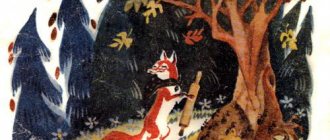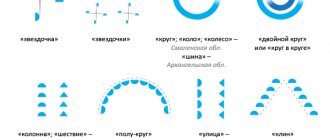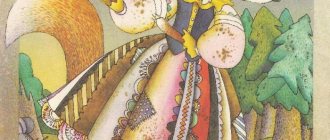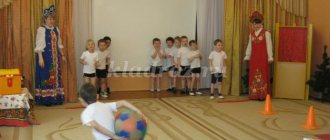Russian folk tales
Russian folk children's fairy tales are very wise and convey a specific lesson to readers. The author of such tales is the Russian people. They were passed down from generation to generation by word of mouth.
There are three types: tales about animals, about magic and everyday tales.
Familiar tales drawn in the style of great artists
Have you ever seen the fairy tale about the Three Little Pigs drawn in the style of Wassily Kandinsky? Or the Ugly Duckling in the style of Vincent Van Gogh? So I don't.
Until I started studying VoiceBook publishing. They came up with the idea of releasing famous fairy tales, but presenting them in illustrations by various great artists.
Thus, at the same time, children learn the fairy tale in a new way, and many get acquainted with famous artists. This is also an incentive to find original works by masters and learn more about them.
Animal Tales
Such tales appeared many years ago. In fairy tales, animals are given human characteristics. In them, animals and birds talk to each other, make peace, swear, get offended, and so on. Here man is on the same level as animals or lower.
Tales of magic
Such tales are based on a miracle. Everything here is fantastic and unreal. A person talks to fantastic characters who do not exist in everyday life. Among the fantastic characters, the following stand out:
- Baba Yaga
- Dragon
- Koschei the Deathless
- Giants and so on.
In a fairy tale, a person deals with unusual things:
- Self-assembled tablecloth.
- Glomerulus
- Needle.
These objects with magical properties do not exist in real life.
Tales about everyday life
These tales illustrate everyday life. They contain both truth and fiction. These tales contrast opposites: rich and poor, young and old, good and evil, weak and strong.
Foreign children's fairy tales
The best fairy tales for children are written by foreign writers. The most popular are the fairy tales of the Brothers Grimm, G. Andersen, O. Wilde, C. Perrault, D. Rodari, V. Hauff. In foreign fairy tales, good always triumphs over evil.
You can listen to such tales online or read them. Children really like to read foreign writers.
The most popular foreign fairy tales:
- Winnie the Pooh. This story was written by Alan Milne. Popular all over the world. This fairy tale teaches you to be brave, kind, friendly, and optimistic.
- The Adventures of Carlson. The story was written by Astrid Lindgren. Here, a little boy befriends an unusual creature with a propeller on its back. A fairy tale teaches that one must always believe in a miracle. Reading this fairy tale, the child understands that in life it is better to approach everything with humor.
- Alice in Wonderland. This piece was written by Lewis Carroll. For a long time it has been in first place in popularity among children all over the world. There is no person who does not love and does not read this fairy tale. Alice travels to amazing places, talks with magical animals. In the process of reading a fairy tale, a child finds himself in a magical world full of mysteries.
Top 10 fairy tales for children 8-12 years old
- Magic tales of Japan. Strawberries under the snow
- Khodza, Zhukrovsky. "Gullible tiger. Burmese, Indonesian, Vietnamese fairy tales"
- Magical tales of Sweden
- Jansson T. “All about the Moomins”
- Kipling R.D. "Mowgli"
- Schmidt A. “Murli”
- Antoine de Saint-Exupery "The Little Prince"
- Jones D.W. "Walking castle"
- Maar P. “Seven Saturdays in a week”
- Jaster N. “Cute and the Magic Booth”
- Ende M. “The Neverending Story”
Small children's tales
Short fairy tales for children are very popular among kids. The child becomes familiar with them from infancy. After all, small children cannot keep their attention on one thing. Long fairy tales are not yet interesting for them.
For kids, it is important that a book with fairy tales has pictures in a hard cover. Such fairy tales can be read to children on the road. Fairy tales teach us to distinguish good from evil, make fun of bad people, teach friendship, and so on.
The most famous short tales are:
- The Tale of the Chicken Ryaba. This fairy tale can be told to children from an early age. It's about how my grandparents couldn't break an egg for days, but the mouse did it with the help of its tail.
- Masha and the three bears. This tale is about a little girl who went into the forest with her friends and got lost. I saw a house in the forest and went there. There she ate porridge and went to bed. And the bears came home and saw that the chair of the smallest bear was broken, the porridge had been eaten. Then he saw Masha sleeping in his bed and screamed. Masha woke up and ran out the window. This fairy tale teaches children not to go into the forest without permission. He says that you can get lost there and get into unpleasant situations.
- Turnip. This fairy tale is about how grandfather planted a turnip. Then she grew and he began to pull her out. His grandmother, granddaughter, cat, and dog helped him drag it. But only with the help of the mouse was he able to pull it out. This fairy tale shows children that they can cope with problems together rather than alone. After all, it is unknown whether he would have been able to pull out the turnip if they had not come to his aid.
Fairy tales for “adult” children
The most difficult age for choosing a book is coming, since it is now that the child turns into a teenager. "Carlson" and "Pinocchio" are left behind, it's time to offer "Gulliver's Travels" or "The Jungle Book", where exciting adventures will coexist with the opportunity to absorb a huge amount of new information.
10-12 years old is the best time to read “The Moomins” and get inspired by Krapivin’s “Flying Fairy Tales”. “The Night Before Christmas” by Gogol, “Little Tsakhes” by Hoffmann - this is both interesting for a child and quite serious, adult reading. This does not mean at all that the young reader “grew up” from the folk tale. It’s just that now this is a completely different reading, which not only teaches us to distinguish between good and evil, but also introduces us to the culture and traditions of the peoples of the world.
Fairy tales that have developed in China, Japan, and India attract with their unusual flavor, but perhaps the child will also notice something in common between the stories he knows from Russian fairy tales and oriental “exoticism.” For example, the motif of magical power possessed by the simplest-looking objects. Running boots, an invisible hat - something similar is in the Japanese fairy tale “What the Birds Told.” An old man finds a cap in the forest, and when he puts it on, he begins to understand the voices of birds. They tell him about a variety of human misfortunes, and, traveling from village to village, the old man saves peasants from troubles and misfortunes. Fate rewards the old man for his responsiveness and love for his neighbor. The villagers surround him with universal respect - and what could be more valuable than respect for old age and wisdom in Eastern culture?
Bedtime Stories
A bedtime story for children is read by parents before bed. It helps the child calm down. Such tales are very kind and instructive. There is no cruelty in them.
Fairy tales teach us to distinguish good from evil, show what is good and bad.
The most popular bedtime stories for babies over one year of age are:
- Swan geese
- Teremok
- Masha and the Bear
- turnip
- The Tale of the Fisherman and the Fish
- Ryaba hen
- The wolf and the seven Young goats
- sleeping Beauty
- Puss in Boots
- Zayushkina's hut.
Interesting children's audio tales
Online fairy tales for children have become popular lately. On the Internet you can listen to various fairy tales online.
It is not necessary to buy collections of fairy tales, because interesting children's fairy tales can be found for free on the Internet.
The most popular children's audio fairy tales:
- Mermaid
- Cars
- The Snow Queen
- Snow White and the Seven Dwarfs
- Three from Prostokvashino
- Little Red Riding Hood
- Aladdin
- Cinderella
- History of toys
- Winnie the Pooh.
You can listen to these tales at any time. Some fairy tales can be included for children at night. Such tales are voiced by announcers, famous actors and singers. Fairy tales have interesting and captivating music. Children love such fairy tales. In them, the heroes of fairy tales come to life, and kids find themselves in a world of magic.
In the usual sense, children's fairy tales are something simple, magical, exciting and certainly with a happy ending. It’s just that the current generation of children craves more action and references to the realities of life, and modern parents want to read children’s books, but so that there is something in them for them too.
Modern children's fairy tales are no longer exactly stories about children's literature. Rather, these are books that are understandable to children and speak the same fairy tale language, but at the same time are interesting to adults too.
And here we can distinguish three main genres, which can be easily traced using the example of the “Pretend” series of the publishing house “Five Quarters”.
A fairy tale in modern realities
Fantastic worlds with unicorns are certainly great. But it’s much more interesting when the fabulous penetrates into ordinary life. This is the same option when a sorceress lives in a neighboring house, and a boy he knows turns out to be nothing less than the lord of darkness.
The boundaries of the fairy-tale and real worlds blur and merge into one. This is the world of “Princess Tornada” by Anna Ignatova.
Tornada is a completely ordinary girl, except maybe a princess and maybe she has magical powers that she doesn’t even know about. Moreover, this is a real state secret and telling the princess that the weather in the kingdom depends on her mood is strictly prohibited.
Tornada goes to school, doesn't like pumpkin puree, falls in love, gets sad and... becomes the victim of a villain who decides to use her abilities as a weapon of mass destruction.
This is both a fairy tale and not a fairy tale at the same time. Yes, there is magic here, on the one hand, but on the other, it’s an ordinary world, where the king and queen behave like ordinary parents and gather a council of psychologists and coaches, boys don’t know how to ride horses, text via smartphones and don’t wear crowns.
“Tornada” is a simple way to translate universal human values into children’s language, to explain complex concepts through irony and understandable situations.
Light modern language with references to things understandable only to adults does not burden the story, but makes it more colorful. Parents will find a lot of Easter eggs for themselves, and will be able to discuss with their children the meanings of certain common nouns, go on a journey into the world of allegories, and, of course, try on a fairy tale plot on their indomitable Tornadoes and Tsunamis.
A philosophical parable wrapped in a fairy tale
The traditional “There is a lie in a fairy tale, but there is a hint in it, a lesson for good fellows” and “And the moral from here is…”, as Lewis Carroll’s duchess liked to say, is an integral part of fairy tales.
What if this is not a children's fairy tale at all? What about a truly philosophical parable, simply skillfully presented in the format of a traditional hero's journey with three friends, three trials and a great mission?
This is the unusual, poignant fairy tale “Derzhioblako” by Anastasia Strokina.
If you look at this story from one side, the children's side, then it's just a fairy tale about a strange magical creature made of feathers and leaves, which goes to look for the Holding Cloud in order to get a recipe from him for fear, and along the way makes a friend - the wolf-like August, the doll McCoy and meets a number of amazing creatures who help him achieve his goal.
And if you read the story with the attentive eyes of an adult, then the fairy tale is revealed as a series of philosophical discourses and debates on the eternal themes of friendship, destiny, honor, pride, and the search for the meaning of life.
Slow, captivating with bright and unusual images, this story helps unite generations of children and parents. He speaks to them in a language they both understand about life, death, betrayal, and even about God, the one who lives on the top of the mountain and can be a mighty cedar, a bushy-tailed wolf fox, and an endless lake.
Unexpected Heroes
Who usually turns out to be the heroes of children's books? As a rule, these are ordinary and not so ordinary boys and girls, less often animals or magical entities, and even less often certain objects. But now, more and more often, you can find fairy tales in which the main character turns out to be someone completely strange, like “Keeping the Cloud” - a creature made of feathers and leaves named Plato or, even stranger, Nanny Wu from the book “Who Are You Nanny Wu? » Ksenia Gorbunova.
Nanny - what’s strange here, you say. Mary Poppins alone is worth it, or Freken Bock, or Christianne Brand's Nanny Horror, or Frau Wolly. Except, Nanny Wu is a robot.
And the book takes place in the distant future, where the floors clean themselves, robots do all the housework, deliver groceries, things, and even work as nannies. And for more than one generation!
So Nanny Wu, suddenly awakened from a long sleep in the attic, discovers that her program is no longer needed, her lullabies are outdated, and the children of her charge do not need it at all.
While reading, children will probably remember the cute robot Valli, and for adults, this story is full of references to Isaac Asimov’s “The Three Laws of Robotics” and “Bicentennial Man,” as well as to the universes created by William Gibson. And it’s all the more interesting to read it with children and watch how a children’s story turns into an amazing journey that transforms the hero.
Can a robot change? Can he change the world around him and the people around him?
A journey story, a story that helps each reader answer the most important question of life, “Who are you?” and what program is inside you and are you ready to change it.
Modern children's writers are fulfilling the main request of young readers: to be different from what was created before and to be in “trend” and on the same wavelength with children. And at the same time, the genre of children's fairy tales is blurring and becoming simply high-quality literature for any age, when the 8+ or 10+ label could easily be replaced with “from 6 to 99 years old.”
Types of online fairy tales
- Russian folk tales.
- Foreign fairy tales.
- For children under three years old.
- Audio fairy tales from four to five years old.
- Long and short online fairy tales.
Fairy tales teach children that good always triumphs over evil. Fairy tales teach that you should never give up. You need to persistently pursue your goal. They help develop creativity.
With their help, the child learns to fantasize, think, and analyze. A fairy tale helps a child find answers to questions of interest.
You don't have to buy fairy tales. You can read and listen to fairy tales online. Younger children love short stories. And children from three to four years old prefer long fairy tales.
Modern fairy tale
A fairy tale is a time-tested way to instill in a child knowledge of how everything works. Fairy tales do not age; they are read and will continue to be read, no matter when they were created. However, this does not mean that fairy tales of the 21st century do not exist.
The fairytale tradition continues today. “The Gruffalo” by Julia Donaldson and Axel Scheffler, “How the Elephant Fell from the Sky” by Kate DiCamillo, “Little Bear Called Paddington” by Michael Bond, “Petson and Findus” by Sven Nordqvist are just a few of the wonderful modern foreign fairy tales. Russia also has its own storytellers: Elena Rakitina and Marina Aromshtam, Evgenia Pasternak and Andrei Zhvalevsky, Dina Sabitova and Sergei Sedov. And more and more new excellent original fairy tales are coming out!
Modern authors of fairy tales focus primarily on the individuality of the child, his personality. Today, fairy tales are not only a storehouse of wisdom or guidance, but also an attempt to communicate with a child in a language he understands. They're still about childhood, friendship, courage and responsibility, but they're often more than just fun stories. Thanks to these fairy tales, a child can look into himself, overcome fears and doubts, and learn to listen to his feelings.
Top 10 Fairy Tales of the 21st Century
- Donaldson D. “Snail and Whale”
- Berner R.S. "Tales about Karlchen"
- Nordqvist S. “Where is my sister”
- Rakitina E. “Seryozhik”
- Zhutaute L. “Tosya-Bosya and the gnome Clean”
- Pasternak E. “Adventures of toys in an ordinary apartment”
- DiCamillo K. “How the Elephant Fell from the Sky”
- Sabitova D. “Circus in a box”
- Zhvalevsky A., Pasternak E. “The True Story of Santa Claus”
- Sedov S. “Hercules. 12 great feats: how it really happened. Eyewitness account"
A fairy tale is more than just a short story with a happy (or not so happy) ending. A folk tale is inextricably linked with the culture of the people on whose land it appeared, but at the same time, the fairy tale stands above nationality. After all, she talks about things that are understandable to all humanity: good and evil, wisdom and stupidity, truth and lies, hatred and love. The author's fairy tale not only offers the little reader a certain moral or immerses him in the twists and turns of a magical plot, but is also often an example of artistic speech.
It is important to read a variety of fairy tales: folk and literary, ancient and modern. After all, fairy tales awaken imagination, reveal the emotional world of a child, give him value guidelines, and form the view of the world with which he will eventually enter adulthood.







